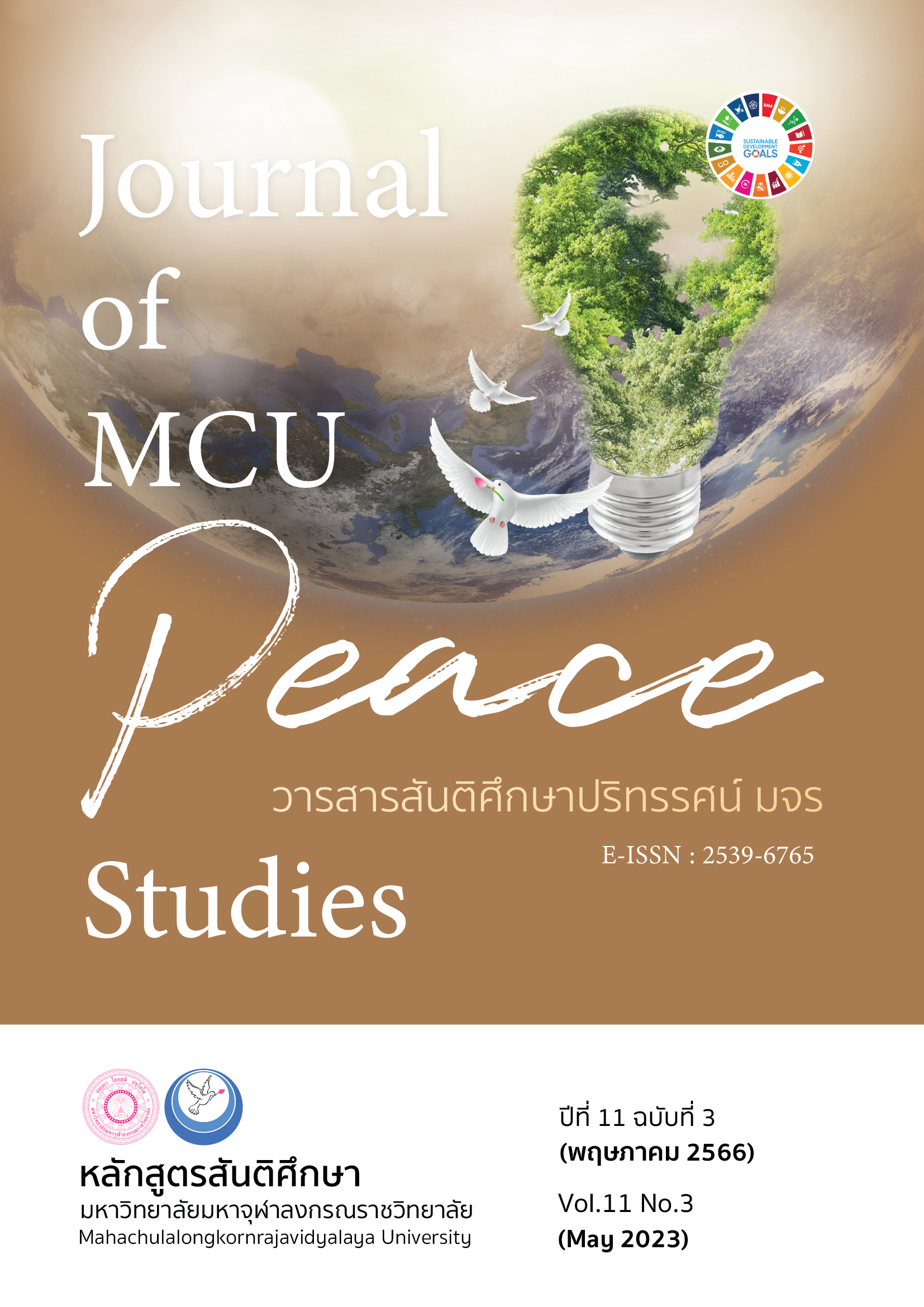รูปแบบของบททำขวัญไทยและเขมร
Main Article Content
บทคัดย่อ
บทความวิจัยเรื่องรูปแบบและเนื้อหาของบททำขวัญไทยและเขมร เป็นการศึกษาวิเคราะห์ตัวบทวรรณกรรมที่ใช้ในการประกอบพิธีทำขวัญของคนไทยและคนเขมร โดยบทความวิจัยนี้มีวัตถุประสงค์เพื่อศึกษารูปแบบและเนื้อหาของบททำขวัญไทยและเขมร โดยใช้ระเบียบวิธีวิจัยเชิงคุณภาพ (Qualitative Research) ประเภทวิจัยเอกสาร (Documentary Research) เป็นแนวคิดสำคัญในการศึกษาวิเคราะห์ ด้วยการวิเคราะห์ตัวบททำขวัญภาษาไทยที่มีการแต่งขึ้นในช่วงพุทธศตวรรษที่ 25 (พ.ศ. 2400-2500) โดยจัดเก็บอยู่ในส่วนงานกลุ่มหนังสือตัวเขียนและจารึก สำนักหอสมุดแห่งชาติ ประกอบด้วย 1) บททำขวัญเด็กทารก 2) บททำขวัญโกนจุก และ 3) บททำขวัญนาค จำนวน 6 บท และบททำขวัญภาษาเขมร คือ 1) บททำขวัญเด็กทารกออกเสียงในภาษาเขมรว่า เฮาปรอลึงบองเกาะชมอบ 2) บททำขวัญโกนจุก ออกเสียงในภาษาเขมรว่า เฮาปรอลึงโกจุก มี 2 สำนวน และ 3) บททำขวัญนาค ออกเสียงในภาษาเขมรว่า สาสตราขวันเนียก จำนวน 4 บท และนำเสนอผลการวิจัยแบบพรรณาวิเคราะห์
ผลการวิจัยพบว่า 1) บททำขวัญไทยและเขมรมีรูปแบบคำประพันธ์ตามความนิยมของผู้ประพันธ์แต่ละชนชาติในท้องถิ่นพื้นที่ของไทยและเขมร บททำขวัญไทยมีรูปแบบคำประพันธ์ด้วยบทร่ายยาว และบททำขวัญเขมรมีรูปแบบคำประพันธ์ด้วยบทร่ายยาวและบทกากคติ และผล 2) บททำขวัญไทยและเขมร มีรูปแบบการดำเนินเรื่องและเนื้อหาประกอบด้วย 3 ส่วน ได้แก่ ส่วนต้น ส่วนเนื้อหา และส่วนท้าย ส่วนต้นของบททำขวัญพบว่ามี 2 องค์ประกอบ คือ บทชุมนุมเทวดาและบทไหว้หรือบทประนาม ส่วนเนื้อหา พบว่า มี 3 องค์ประกอบ คือ บทเกริ่นนำ บทเชิญขวัญและบทปลอบขวัญ และส่วนท้ายพบว่ามี 2 องค์ประกอบ คือ บทปัดเคราะห์และบทให้พร เพื่อร้องเชิญชวญให้ขวัญกลับคืนมาหาเจ้าของตามคติความเชื่อในเรื่องขวัญที่คล้ายคลึงกันของคนไทยและคนเขมร
Article Details

อนุญาตภายใต้เงื่อนไข Creative Commons Attribution-NonCommercial-NoDerivatives 4.0 International License.
ทัศนะและความคิดเห็นที่ปรากฏในบทความในวารสาร ถือเป็นความรับผิดชอบของผู้เขียนบทความนั้น และไม่ถือเป็นทัศนะและความรับผิดชอบของกองบรรณาธิการ ยินยอมว่าบทความเป็นลิขสิทธิ์ของวารสาร
เอกสารอ้างอิง
Hongsuwan, P. (2018). Folklore and Social. KhonKaen: Klangnana.
Jiensuwan, S. (2003). An Analytical Study of Tham Khwan Texts and Rituals of the Thai, Phuan and Khmer Ethnic Groups in Changwat Chachoengsao. (Master’s Thesis). Chulalongkorn University. Bangkok.
Khanittanan, W. (n.d). Tham Khwan Ceremony of Tai People. Bangkok: Thammasat University.
Khing, H. (2004). Notes Sur La Ceremonie de L’appel des Esprits Vitaux. Phnom Penh: Angkor.
Ly, S. (2006). Pi Thii Haw Praling Taam Ra-Biep Khmer Bo-Ran. Phnom Penh: Meng Haw.
National Library of Thailand, Manuscripts and Inscriptions Group. (n.d.). Ms. No. 233. Category Literature. Sub Rai. Thai language.
______. (n.d.). Ms. No. 272. Category Literature. Sub Rai. Thai language.
______. (n.d.). Ms. No. 274. Category Literature. Sub Rai. Thai language.
______. (n.d.). Ms. No. 276. Category Literature. Sub Rai. Thai language.
______. (n.d.). Ms. No. 281. Category Literature. Sub Rai. Thai language.
______. (n.d.). Ms. No. 287. Category Literature. Sub Rai. Thai language.
Nimmanahaeminda, P. (2017). Tai Folklore in Rice Culture. Bangkok: Chulalongkorn University.
Pakdeekam, S. (2007). Relationship in Literature of Thai-Khmer. Bangkok: Amarin.
Saisang. P. (1988). Examples of Literature Appear in the Lanna Tradition. Proceedings of the Academic Seminar Lanna Cultural Traditions. Chiang Mai: Chiang Mai Teachers' College.
Sappasan, P. (2003). An Analysis of “SUKHWAN” Verses of Kui Tribesmen in Srikhoraphum District Surin Province. Bangkok: Princess Maha Chakri Sirindhorn Anthropology Centre.
Satienkoses, A. (1963) Khwan and Tham Khwan Ceremony. Bangkok: Kawnaa.
Terwiel B. (1980). The Tai of Assam and Ancient Tai Ritual Volume 1: Life-Cycle Ceremonies. Gaya, India: The Centre for South East Asian Review office.
The Buddhist Institute Edition. (1968). Khmer Dictionary. Phnom Penh: Buddhist Institute.
______. (2013). Dictionary of the Royal Institute B.E. 2554. (2nd ed.). Bangkok: Nanmeebooks Publication.
Thongruang, B. (1993). Soul-Calling Verse in Isan Literature. (Master’s Thesis). Srinakhariwirot University. Mahasarakham.
Weesapen, W. (2015). Bai Sri Soo Khwan in Thai Society. Mahasarakham: Mahasarakham University.


